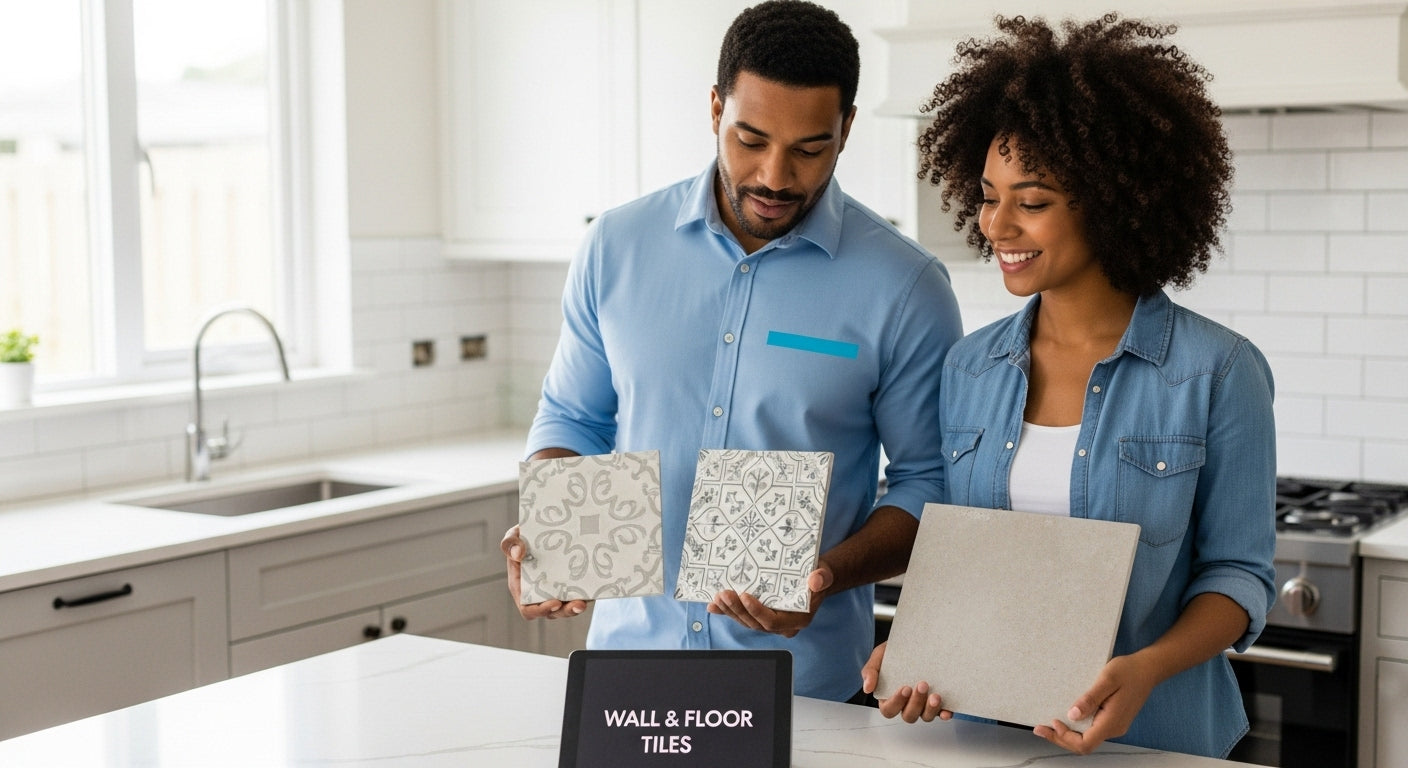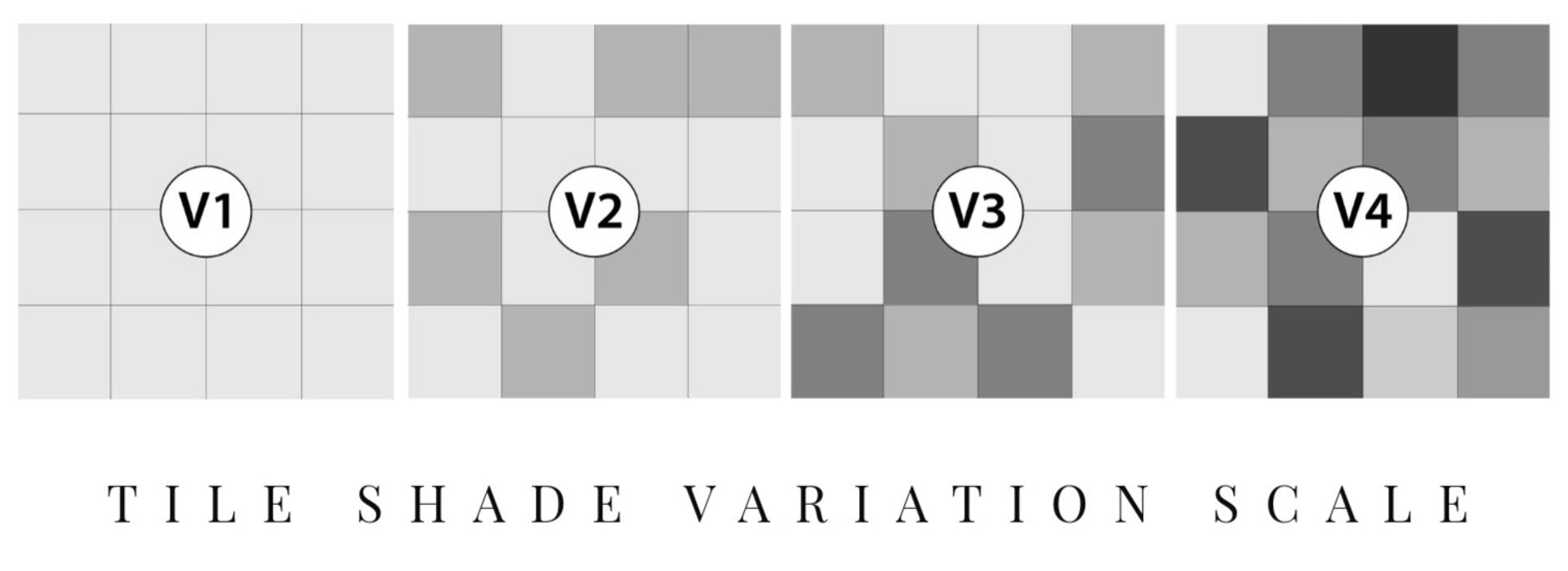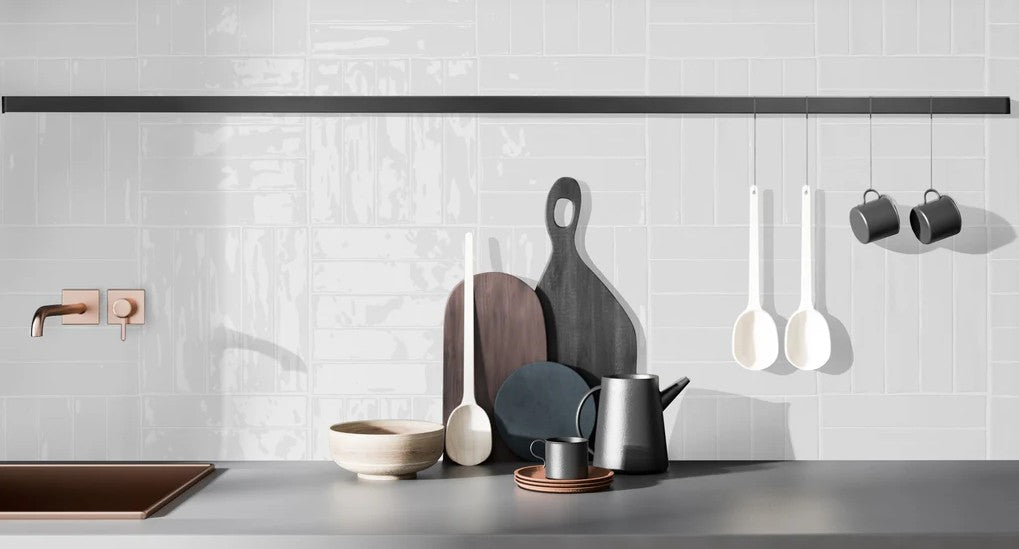Choosing between wall tiles and floor tiles can seem simple at first. Here is something most people miss. Wall tiles are often 30 to 40 percent thinner than floor tiles and focus on decoration rather than strength. That detail means picking the wrong kind of tile for your space can actually lead to safety risks, extra costs, and some big style regrets.
Table of Contents
- What Are Wall Tiles And Floor Tiles?
- Why Choosing The Right Tile Matters
- Key Differences In Material And Design
- How Installation Influences Tile Selection
- Practical Applications In Various Spaces
Quick Summary
| Takeaway | Explanation |
|---|---|
| Choose wall tiles for aesthetics. | Wall tiles are lighter, thinner, and focus on decorative appeal for vertical surfaces. |
| Select floor tiles for durability. | Floor tiles are thicker and designed to withstand heavy use and foot traffic. |
| Match tiles to intended use. | Specific tiles are necessary to ensure optimal performance and safety in different environments. |
| Consider installation requirements. | Preparation and compatibility with underlying surfaces are key for effective tile installation. |
| Evaluate performance metrics for commercial spaces. | High-traffic areas require tiles with specific durability and resistance features to prevent wear and safety issues. |
What Are Wall Tiles and Floor Tiles?
When exploring tile options for home renovation, understanding the fundamental difference between wall and floor tiles becomes crucial for achieving both aesthetic and functional success. While these tile types might seem similar at first glance, they possess distinct characteristics that make them suitable for specific applications.
Defining Wall Tiles
Wall tiles are specifically designed for vertical surfaces, focusing primarily on aesthetic appeal and decorative purposes. According to the National Park Service, these tiles are characteristically thinner and lighter, engineered to create visual interest without bearing significant weight. Their primary functions include:

- Protecting wall surfaces from moisture and stains
- Enhancing interior design aesthetics
- Providing easy-to-clean surface coverings
Typically, wall tiles feature more intricate designs, delicate glazes, and decorative patterns since they do not experience direct physical stress like floor tiles. Manufacturers often prioritize visual complexity and color variation in wall tile production.
Understanding Floor Tiles
In stark contrast, floor tiles are engineered for durability, strength, and functionality. These tiles must withstand substantial weight, foot traffic, and potential impacts. As noted in the previous research, floor tiles are thicker, more robust, and specifically designed with slip-resistant properties to ensure safety.
Key characteristics of floor tiles include:
- Higher density and compressive strength
- Enhanced wear and tear resistance
- Textured surfaces for improved traction
- Greater thickness compared to wall tiles
While wall tiles focus on beauty, floor tiles balance aesthetics with practical performance requirements.
Below is a table summarizing the main differences between wall tiles and floor tiles, allowing for quick and clear comparison of their features and typical uses.
| Feature | Wall Tiles | Floor Tiles |
|---|---|---|
| Primary Purpose | Decorative and aesthetic on walls | Durable, functional surface for floors |
| Thickness | Thinner (30-40% less than floor tiles) | Thicker to handle pressure and impact |
| Weight | Lighter | Heavier |
| Strength | Lower strength, not made for heavy loads | High strength for foot and impact resistance |
| Surface Finish | Intricate, decorative glazes | Textured, slip-resistant |
| Placement | Vertical surfaces (walls, backsplashes) | Horizontal surfaces (floors) |
| Suitability for Traffic | Low/none | Medium to heavy foot traffic |
| Typical Materials | Ceramic, delicate finishes | Porcelain, robust composites |
If you want to explore more about tile varieties, check out our comprehensive guide on understanding different types of floor tiles that can help you make informed design decisions for your space.
Why Choosing the Right Tile Matters
Selecting the appropriate tile for specific areas in your home goes far beyond mere aesthetic preferences. The wrong tile choice can lead to significant functional challenges, increased maintenance costs, and potential safety risks. Understanding the critical importance of matching tiles to their intended use becomes essential for successful home design and long-term durability.
Performance and Functionality Considerations
Tile selection directly impacts the performance and longevity of your surfaces. According to Ceramic Tile Manufacturers Association, different areas require specific tile characteristics to ensure optimal functionality. For instance, bathroom floor tiles need superior water resistance and slip protection, while kitchen backsplash tiles demand easy-to-clean surfaces with heat-resistant properties.
Key performance factors include:
- Moisture absorption rates
- Impact resistance
- Thermal stability
- Chemical resistance
- Friction coefficient
Safety and Durability Implications
The wrong tile can create significant safety hazards. In high-traffic areas like kitchens, bathrooms, and entryways, selecting tiles with inadequate slip resistance can dramatically increase accident risks. Professional designers recommend evaluating tile texture, surface finish, and coefficient of friction to prevent potential injuries.
Tile durability directly correlates with material selection and intended use. Soft, decorative wall tiles placed on floors will quickly deteriorate under foot traffic, while industrial-grade floor tiles might appear unnecessarily harsh in delicate interior design settings. The financial implications of premature tile replacement can be substantial, making initial careful selection crucial.
This table outlines the key performance and durability considerations when selecting tiles, helping readers quickly understand what metrics matter for specific environments.
| Consideration | Description | Why It Matters |
|---|---|---|
| Moisture Absorption | Rate at which tile takes in water | Impacts suitability for bathrooms/kitchens |
| Slip Resistance | How well the tile prevents slipping | Critical for safety in wet areas |
| Impact Resistance | Ability to withstand drops and foot traffic | Longer lifespan, less maintenance |
| Chemical Resistance | Ability to withstand cleaning agents and stains | Important for kitchens/healthcare spaces |
| Friction Coefficient | Measurement of traction provided by the tile surface | Affects safety, especially in high-traffic |
| Thermal Stability | Resistance to temperature changes | Relevant for outdoor and heated floors |
For those looking to dive deeper into tile selection nuances, explore our comprehensive guide on mixing tile patterns for stunning spaces to understand how material choice impacts overall design aesthetics and functionality.
Key Differences in Material and Design
Tile materials and design variations play a pivotal role in determining their suitability for specific applications. Understanding the nuanced differences between wall and floor tiles goes beyond mere visual appeal, encompassing complex engineering considerations that impact performance, durability, and aesthetic potential.
Structural Composition and Manufacturing
The fundamental difference between wall and floor tiles lies in their structural composition. According to the National Research Council of Canada, tile manufacturing processes are carefully tailored to meet specific functional requirements. Floor tiles are engineered with higher density and more robust materials to withstand substantial physical stress, while wall tiles prioritize lightweight construction and decorative potential.
Key manufacturing differences include:
- Thickness variations (floor tiles are significantly thicker)
- Density and compression levels
- Surface treatment techniques
- Raw material selection
- Production temperature and cooling processes
Surface Finish and Performance Characteristics
Surface finish dramatically influences tile performance and aesthetic appeal. Floor tiles require textured, slip-resistant surfaces that provide traction and safety, whereas wall tiles can explore more delicate and intricate surface treatments. The coefficient of friction becomes a critical factor in floor tile design, directly impacting user safety in high-traffic areas.
Material selection further distinguishes these tile types.
 Porcelain and ceramic compositions are engineered with specific performance attributes, with floor tiles incorporating more robust aggregates and reinforcement materials to enhance structural integrity.
Porcelain and ceramic compositions are engineered with specific performance attributes, with floor tiles incorporating more robust aggregates and reinforcement materials to enhance structural integrity.
For design enthusiasts interested in exploring surface aesthetics further, learn about the subtle differences between matte and glossy tile finishes to understand how surface treatment impacts overall design perception.
How Installation Influences Tile Selection
The complexity of tile installation extends far beyond simply placing materials on a surface. Professional tile selection requires understanding intricate installation requirements that directly impact long-term performance, durability, and aesthetic quality. Tile selection becomes a strategic decision influenced by substrate conditions, environmental factors, and specific installation techniques.
Substrate Preparation and Compatibility
Substrate preparation represents a critical initial phase that significantly influences tile selection. According to the General Services Administration, successful tile installation demands careful evaluation of surface conditions, including:
- Structural integrity of underlying surfaces
- Moisture resistance and waterproofing requirements
- Flatness and evenness of installation areas
- Load-bearing capacity of supporting structures
- Potential thermal expansion characteristics
Different installation environments require specific tile characteristics. Bathrooms, kitchens, and exterior spaces each present unique challenges that necessitate carefully matched tile selections. Moisture-prone areas demand tiles with low water absorption rates and robust adhesive compatibility.
Technical Installation Considerations
Installation techniques profoundly impact tile performance and longevity. Professional installers must consider multiple technical factors, including mortar coverage, expansion joint placement, and grout selection. Floor tiles require more robust installation methods compared to wall tiles, with stricter requirements for load distribution and impact resistance.
Professional designers understand that installation complexity influences material selection. Larger format tiles, intricate patterns, and specialized surface treatments demand advanced installation expertise and specific preparation techniques.
For design enthusiasts seeking inspiration beyond technical considerations, explore our timeless tips for selecting vintage tile patterns to understand how historical design approaches can inform contemporary tile selections.
Practical Applications in Various Spaces
Selecting the right tile for specific spaces requires a nuanced understanding of performance requirements, aesthetic considerations, and functional demands. Each area within a home or commercial environment presents unique challenges that influence tile selection, making material choice a critical design decision.
Residential Space Considerations
According to the U.S. National Park Service, ceramic tiles offer versatile solutions across different residential environments. Different spaces demand specialized tile characteristics, with each room presenting distinct functional and aesthetic requirements.
Key residential tile application zones include:
- Kitchen backsplashes requiring heat and stain resistance
- Bathroom floors needing slip-resistant surfaces
- Living room accent walls demanding decorative elegance
- Entryways requiring high durability and wear resistance
- Outdoor patios necessitating weather-resistant materials
Commercial and High-Traffic Areas
Commercial environments amplify the importance of strategic tile selection. Restaurants, hospitals, retail spaces, and office buildings require tiles that can withstand intense foot traffic, frequent cleaning, and potential chemical exposures. Floor tiles in these settings must demonstrate exceptional durability, minimal porosity, and consistent performance under challenging conditions.
Performance metrics become paramount in commercial tile selection. Factors such as coefficient of friction, impact resistance, and chemical stability directly influence tile suitability for specific professional environments. Designers and facility managers must evaluate tiles based on comprehensive performance criteria beyond aesthetic considerations.
For those seeking inspiration in tile design that balances functionality with visual appeal, read our guide on mixing tile patterns for stunning spaces to understand how strategic material selection can transform interior environments.
Ready to Choose the Perfect Tile for Your Space?
Selecting the right wall and floor tiles can be overwhelming. If you worry about making costly mistakes, risking durability, or sacrificing style, you are not alone. Many readers of our guide on wall and floor tile differences feel unsure about material choices, slip resistance, or matching design and function for each room.

Trust TileChoices.com to take the guesswork out of your renovation. Explore our curated collections of modern ceramic and porcelain tiles, with detailed photos, specs, and easy sample requests. Get inspired with our tips for mixing tile patterns for stunning spaces or learn more about how surface finish, like matte vs. glossy tiles, affects your project. Visit us today and get expert guidance for a flawless finish that is beautiful, safe, and built to last.
Frequently Asked Questions
What is the primary difference between wall tiles and floor tiles?
Wall tiles are designed for vertical surfaces and prioritize aesthetics, whereas floor tiles are engineered for durability, strength, and specific performance characteristics suitable for high foot traffic.
Can wall tiles be used on the floor?
While it’s technically possible to use wall tiles on the floor, they are generally not recommended due to their lighter construction and lack of slip resistance, which can lead to safety issues and premature wear.
What factors should be considered when choosing tiles for bathrooms?
When selecting tiles for bathrooms, consider moisture resistance, slip resistance, and ease of cleaning, as these factors significantly influence safety and maintenance.
How does tile thickness affect performance?
Tile thickness influences its durability and strength; floor tiles are typically thicker to withstand pressure and impact, while wall tiles are thinner and lighter, focusing more on decorative appeal.
Recommended
- Understanding the Different Types of Floor Tiles – Tile Choices
- Understanding Matte vs Glossy Tiles: Key Differences Explained – Tile Choices
- Understanding Glazed vs Unglazed Tiles: A Clear Guide – Tile Choices
- Understanding Porcelain vs Ceramic Tiles: A Comprehensive Guide – Tile Choices









